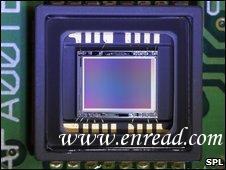| ||||||||||||||||||||||||||||||||||||||||||||||||||||||||||||||||||||||||||||||||||||||||||||||||||||||||||||||||||||||||||||||||||||||||||||||||||||||||||||||||
|
The fastest imaging system ever devised has been demonstrated by researchers reporting in the journal Nature. 自然杂志中研究人员向世人展示了世界上最快的成像系统。 The technique hinges on an ordered spreading of the colours in laser light Their camera snaps images less than a half a billionth of a second long, capturing over six million of them in a second continuously. It works by using a fast laser pulse dispersed1(分散的) in space and then stretched in time and detected electronically. The approach will be instrumental in analysing, for example, flowing blood samples in a search for diseased cells. What is more, the camera works with just one detector2, rather than the millions in a typical digital camera. Dubbed4 Serial5 Time-Encoded Amplified6 imaging, or Steam, the technique depends on carefully manipulating so-called "supercontinuum" laser pulses. These pulses, less than a millionth(百万分之一的) of a millionth of a second long, contain an enormously broad range of colours. Two optical elements spread the pinprick(针刺) laser pulses into an ordered two-dimensional array of colours. It is this "2-D rainbow" that illuminates7(阐释,说明) a sample. Part of the rainbow is reflected by the sample - depending on light and dark areas of the illuminated8 spot - and the reflections travel back along their initial path. Because the spreading of the pulse's various colours is so regular and ordered, the range of colours reflected contains detailed9 spatial10 information(空间信息) about the sample. "Bright spots reflect their assigned wavelength11 but dark ones don't," explained Bahram Jalali, the University of California, Los Angeles professor who led the research. "When the 2-D rainbow reflects from the object, the image is copied onto the colour spectrum12(色谱) of the pulse." The pulse then passes back through the dispersive13(分散的) optics and again becomes a pinprick of light, with the image tucked away within as a series of distributed colours. However, that colour spectrum is mixed up in an exceptionally short pulse of light that would be impossible to unpick in traditional electronics. The team then routes the pulse into a so-called dispersive fibre - a fibre-optic cable that has a different speed limit for different colours of light. As a result, the red part of the spectrum races ahead of the blue part as the pulse travels along the fibre. Eventually, the red part and blue part separate in the fibre, arriving at very different times at the fibre's end. All that remains14 is to detect the light as it pops out of the fibre with a standard photodiode(光电二极管) and digitise it, assigning the parts of the pulse that arrive at different times to different points in two-dimensional space. The result of all this optical trickery(欺骗,诡计): an image that represents a snapshot just 440 trillionths(一万亿分之一) of a second long. The researchers used a laser that fired more than six million pulses in a second, resulting in as many images. However, they say that the system can be improved to acquire more than 10 million images per second - more than 200,000 times faster than a standard video camera. While other cameras used in scientific research can capture shorter-lived images, they can only capture about eight images, and have to be triggered to do so for a given event. The Steam camera, by contrast, can capture images continuously, making it ideal for random17 events that cannot be triggered. Some applications that may benefit from the approach include observing the communication between cells, or the activity of neurons(神经原,神经细胞). But the perfect example of an application for the Steam camera's specifications18 is analysing flowing blood samples. Because the imaging of individual cells in a volume of blood is impossible for current cameras, a small random sample is taken and those few cells are imaged manually with a microscope. "But, what if you needed to detect the presence of very rare cells that, although few in number, signify early stages of a disease?," asks Keisuke Gode, lead author of the study. Dr Gode cites circulating tumour19 cells(肿瘤细胞) as a perfect example of such a target. Precursors20(先驱者,前导) to metastasis(转移), they may exist as only a few among a billion healthy cells. "The chance that one of these cells will happen to be on the small sample of blood viewed under a microscope is virtually negligible." But with the Steam camera, fast-flowing cells can be individually imaged. The team is working to extend the technique to 3-D imaging with the same time resolution, and to increase the effective number of "pixels" in a given image to 100,000. "Our next step is to improve the spatial resolution(空间分辨率) so we can take crystal clear pictures of the inner structure of cells," Professor Jalali told BBC News. "We are not there yet, but if we are able to accomplish this, then there is no shortage of applications in biology." 点击  收听单词发音 收听单词发音
|
||||||||||||||||||||||||||||||||||||||||||||||||||||||||||||||||||||||||||||||||||||||||||||||||||||||||||||||||||||||||||||||||||||||||||||||||||||||||||||||||
- 发表评论
-
- 最新评论 进入详细评论页>>





